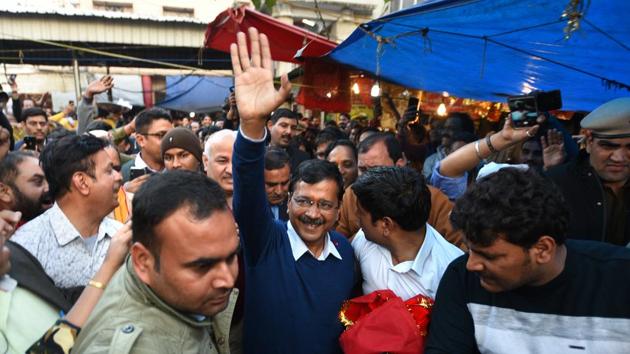Can Arvind Kejriwal go national, asks Rajdeep Sardesai
There is a vacuum in the Opposition leadership space. But the Delhi CM has his own limitations
The emergence of Arvind Kejriwal has undoubtedly been the start-up story of Indian politics in the last decade, just as the inexorable rise of Narendra Modi has been the biggest brand revolution over this period.

For their devout followers, both symbolise hope and change, albeit in starkly different ways. If the Aam Aadmi Party (AAP) leader represents the dream of a more socially conscious, egalitarian India, the Bharatiya Janata Party (BJP) mascot is the flag-bearer of unalloyed Hindutva politics, where religio-nationalist zeal is at the core of a new India vision. Both leaders swear by a good governance model premised on populist welfarism and, yes, both are fiercely individualistic and are their own respective party high commands.
So, as Kejriwal storms back to power with another remarkable majority in the Delhi Vidhan Sabha elections, the question might inevitably be asked: Can the AAP leader be a future challenger to Prime Minister Modi? Well, yes and no. As the widely contrasting results of the Delhi Vidhan Sabha and Lok Sabha in the last year have shown, the voter is making a sharp distinction between state and national elections. The near-complete identification of every state government scheme with the chief minister has meant that the same voter who is attracted by Modi’s muscular leadership at a national level is unhesitatingly willing to make the switch to Kejriwal in a state contest. This easy swap — we saw it in Delhi 2014-15 as well — reflects a transactional voter who is less likely to be swayed by high-pitched emotional rhetoric in a more localised “bijli-paani-school-mohalla clinic” election milieu.
In effect, Kejriwal is recognised and now trusted as the face of Delhi. But this also limits his potential to expand his brand value beyond the national capital which, after all, is ultimately a city-state with just seven Lok Sabha Members of Parliament. In Mumbai, for example, the Shiv Sena, for decades, has played the role of benefactor at the local level; its network of shakha pramukhs (branch heads) has created a regional connect that ensures the party’s dominance in the cash-rich Brihanmumbai Municipal Corporation (BMC). Can a Kejriwal, with his focused service delivery model, offer an alternative to a corruption-tainted BMC? Not unless the AAP is able to create a local organisation that can identify with the unique ethos of the city— an agenda for civic governance needs a distinct regional dimension in different parts of the country.
The limitations of the AAP were exposed in 2017 in Goa and Punjab, two states where the party made a concerted attempt to expand. In Punjab, the AAP’s original anti-corruption agenda resonated for a while, but the failure to identify and empower a local Sikh leadership prevented the party from taking advantage of the initial momentum. In Goa too, the complex nature of panchayat-driven village societies meant that the AAP was seen as a party of outsiders in a starkly parochial political environment.
Moreover, while the AAP has established itself as Delhi’s premier political party, it hasn’t been able to change the political ethos in a manner that would make it an attractive option for those fatigued with mainstream politics. The list of winning AAP legislators includes some bright, young minds, but it is also populated by defectors and moneybags. The idealism of the Anna Hazare anti-corruption movement has been compromised by the harsh realities of electoral politics. Kejriwal’s reluctance to build a second line of leadership outside the shadow of the Supreme Leader has meant that the AAP is still burdened, like many regional outfits, with the one-leader show tag.
And yet, politics often does offer a second innings for those willing to learn from past mistakes. Kejriwal 2.0 appears a more sober avatar of his earlier perpetually angry man image. This isn’t the Kejriwal of Varanasi 2014 vintage when he attempted to punch above his weight by directly challenging Modi. He has, in fact, studiously avoided any embittered references to the prime minister since 2017. Instead, we now have a newly-minted Brand Kejriwal who offers a peculiar, de-ideologised mix of robust nationalism (witness his stand on Article 370), cultural Hinduism (the repeated invocation of Hanuman) and pro-poor welfarism in an attempt to position himself as a more inclusive Right-of-centre alternate to the BJP’s polarising Hindutva politics.
Crucially, Kejriwal’s latest election triumph also comes at a time when the Congress is in a deepening organisational and leadership crisis. In particular, the inability of Rahul Gandhi to be seen as a leader of substance has meant that the opposition leadership space remains wide open. It is unlikely that senior leaders like a Mamata Banerjee or a Sharad Pawar will cede that space to a relatively junior Kejriwal. But the anti-Modi coalition will continue to push for credible alternatives in the build-up to 2024. As a self made IITian, anticorruption crusader, Kejriwal remains an inspirational story for a middle-class aspirational India. Without the baggage of dynasty, he may get another chance to tilt at Modi so long as he stays patient. Till then, Dilli dur ast.
Post-script: There is another curious link to the Modi-Kejriwal story: Ace election strategist Prashant Kishor, once a Modi man, is now firmly in the Kejriwal camp, having contributed in no small measure to his Delhi win. Kishor’s clients now include a diverse range of anti-Modi forces from Mamata to Stalin. Will he now seek to glue them together into a broad national coalition? Watch this space.
Rajdeep Sardesai is a senior journalist and author. His latest book is 2019: How Modi Won India
The views expressed are personal




